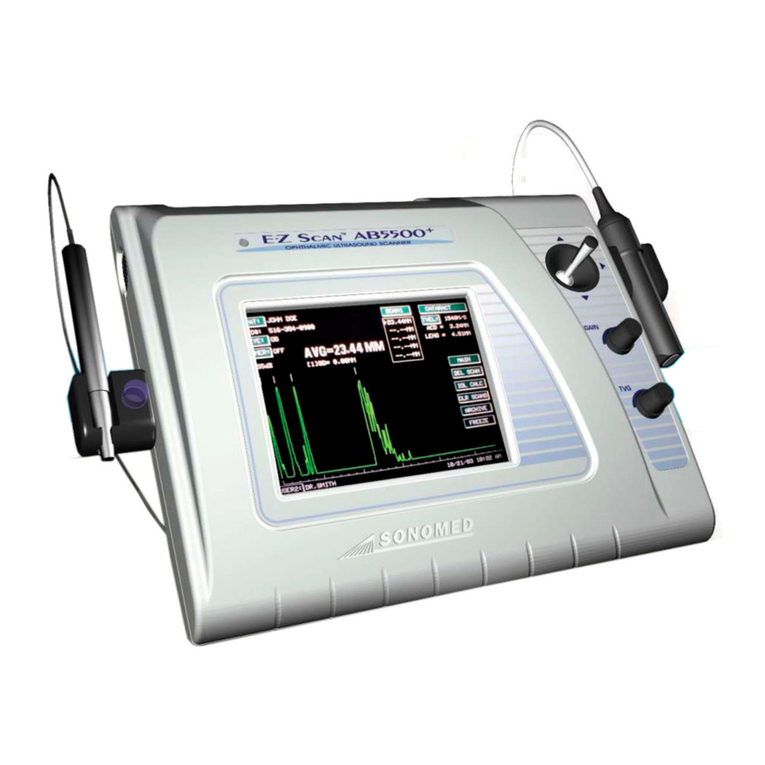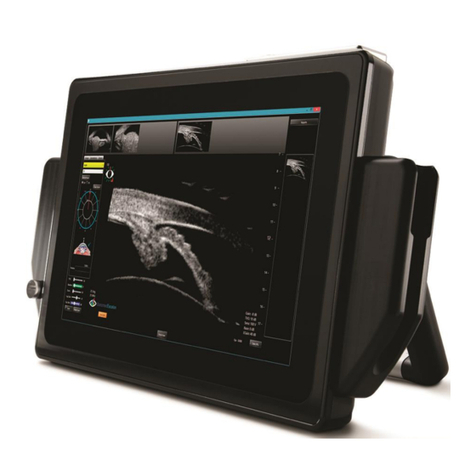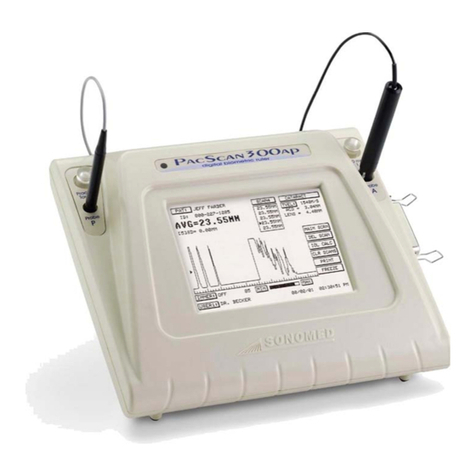Sonomed MD4 User manual

1. Applications
The pocket-size Doppler blood flow detector is a simple device enabling wide range of easy
and reliable diagnostics of blood flow in neck, extra-cranial, upper and lower extremities
vessels.
The small size and rechargeable battery-powered operation make MD4 portable while the
built-in loudspeaker and a headphone jack allow for its use in any environment. It can be
especially handy when a quick assessment of vessels’ patency is required or when the pulse
is weak or undetectable using other methods. It can be used for regular medical check-ups, at
the patient’s bed, at home and in hospitals.
This detector can only be used by medical personnel trained in localization of blood vessels
and interpretation of acoustic Doppler signals.
2. Using the device
Sonomed Doppler is designed with ease of use in mind. The ultrasonic probe is
connected to the pair of round sockets marked with symbol. The ON and OFF
buttons serve to switch the device on and off, respectively. The two buttons with a speaker
symbol on them turn the volume up and down as indicated by the arrows beside the speaker
symbols. After powering on, MD4 is set to middle volume level. A green light above the ON
button indicates that the device is turned on. Blinking light means that recharging is required.
The device can be used for a short time after which automatic turning off will occur to
protect the battery. Never enforce operation by keeping the ON button pressed in such a case
(this will lead to battery damage). The recharge should be performed on the same day if
possible. Connect the charger to the headphone jack at the bottom of MD4 (marked with )
and then plug it into a 230V mains outlet A red light beside the jack indicates the charging
process and it turns off after about 15 hours. The unit will not turn on while charging. The
same jack is used to connect headphones. Plugging them in automatically disables the
loudspeaker. In case of lack of input signals, the device will turn off after a few minutes to
preserve battery.
3. Medical examination
The front of the probe or patient’s skin should be covered with Ultrasound Gel to assure
good acoustic coupling. It’s better to apply an excess of than too little Ultrasound Gel. The
automatic noise control reduces initial noise and strong signals from probe movements but
applying Ultrasound Gel to the probe isn’t advisable when working with maximum volume.
Put the ultrasound probe above the examined vessel at an angle that produces the loudest
acoustic signal. Usually, this angle varies between 45 and 60 degrees. Do not use excessive
force when pressing probe to patient’s body as it could cause pain and obstruct blood flow. In
rare cases, the Ultrasound Gel can cause allergic reaction of patient’s skin. Please use sterile
probe sheath when there is possibility of probe contact with patient’s damaged skin.
The Doppler signal detected in normal arteries generally contains three easily
differentiated flow phases: first, louder and with higher frequency (higher pitch) and two
other, with lower intensity and frequency (lower pitch). The first sound can be likened to a

3
strong whistle of wind, while the remaining two are more like a quiet hum. In slightly
narrowed arteries the third phase disappears and in extremely narrowed arteries (more than
50 %) only the first phase connected to systole can be heard. Such a signal usually has a
higher frequency and sounds like hiss. Below the narrowing, the sound has more complex
character. It consists of high frequency caused by acceleration of flow with overlapped low
and booming tone, produced by turbulent flow caused by the narrowing. The Doppler signal
from stenosed vessels has higher frequency in the first, systolic phase. The successive phases
are considerably faded down or they disappear completely.
The Doppler diagnosis helps to investigate blood flow, localize stenosis and occlusions.
The unit can successfully replace the stethoscope for measurements of blood pressure in
patient with difficult-to-hear Korotkoff sounds. This application is especially important in
detecting peak systolic pressure (measured with cuffs and a sphygmomanometer). The most
common application is ABI (ankle-brachial index) calculation.
4. Terms of use
Sonomed Doppler should be operated within the range of environment temperature from
10°C to 45°C in relative humidity not exceeding 85% and atmospheric pressure 70-106 kPa.
Do not expose it to extreme heat or to extreme cold.
Special care is necessary for the probe. Always ensure that the probe is securely
connected to the main unit. Avoid exposing the probe to mechanical shocks. Especially, do
not bump the front of the probe against hard surfaces or press on it and protect its surface
from scratching. For examinations, use only CE marked ultrasound gel. It is a recommended
practice to always wipe the probe with a damp swab immediately after use, ensuring that any
remaining gel is removed. Do not use organic solvents. Only mild cleaning and disinfecting
liquids are recommended (water and alcohol based). Before examination, the working part of
the probe should be disinfected with certified liquid preparation according to manufacturer’s
instruction. Do not soak cables and connectors.
Keep in mind that this device has limited resistance to electromagnetic interference
(EMI). Avoid using it near EMI sources (e.g. cellphones or diathermy).
For shipment and transportation, the probe should be disconnected from the main unit.
To disconnect, pull on sliding cylindrical sheaths on the connectors. Never pull on the cables
to disconnect them, since the connectors are equipped with special latches preventing
accidental disengagement. You can connect either connector to either socket on the main
unit.
Charging can only be performed using the
charger supplied by device manufacturer.
Using the unit is not allowed during charging.
When connecting the charger and charging, the
set has to be outside the patient area (according
to 60601-1). An example of such area is shown
in the illustration.
Warning: if the charger is wet or has broken
housing, plugging to the mains is forbidden.

In case of damage to any part of the device or of any concerns regarding the correct operation
of the device, please contact Sonomed. There are no user serviceable parts inside unit. Do not
open it as this will cause voiding your warranty and increased service costs post-warranty.
The service check of the device should be performed in the third, fifth and seventh year since
purchase. The intended lifetime of the instrument is 10 years.
5. Technical tips
When the green light starts blinking, it is advised to stop using the device and perform a
full charge cycle.
When the device is continued to be used when the light is blinking, after some time the
automatic shutdown circuit will turn the device off. In such case, it is necessary to
perform charging.
If the device turns off immediately after powering on, perform a full charge cycle.
Never force the unit on by keeping the ON button depressed after the automatic shutdown
occurred. Doing this will lead to battery damage due to deep discharge
After you finish using the device, make sure it is turned off.
If no sound comes from the loudspeaker, make sure that no headphones or charger is
connected
If no Doppler signal can be achieved, make sure that the probe frequency corresponds to
your main unit and a proper amount of ultrasound gel is applied between the probe and
skin.
Always disconnect the probe by pulling on sliding cylindrical sheaths on the connectors
so that the built-in latches are disengaged. Never pull on the cables to disconnect the
probe.
6. Medical exam tips
It is better to use too much, rather than too little ultrasound gel.
Do not press on the skin too hard with the probe, as this will cause obstructed flow
in the examined vessel and may cause discomfort.
With patients who are cold, the vessels may be constricted (especially in
extremities), which makes detecting the flow more difficult.

7
7. Technical specification
Ultrasonic frequency 5 MHz (MD4) or 8MHz (MD4-CW8)
Frequency response 300 Hz-6 kHz
Ultrasound output P_<1MPa, Iob<20mW/cm2, Ispta<100mW/cm2
Rechargeable battery 3,6 V, 1500 mAh
Audio output (loudspeaker) >200 mW (sin)
Headphone acoustic output mini jack 3.5
Dimensions 17 x 7,5 x 2,5 cm
Weight with battery 280 g
Standard package includes: MD4 Doppler unit, CW5 ultrasonic transducer (for MD4-
CW8: CW8 option FCW8), battery charger, gel, user manual, headphones.
Class IIa
This manual suits for next models
1
Table of contents
Other Sonomed Medical Equipment manuals
Popular Medical Equipment manuals by other brands

Getinge
Getinge Arjohuntleigh Nimbus 3 Professional Instructions for use

Mettler Electronics
Mettler Electronics Sonicator 730 Maintenance manual

Pressalit Care
Pressalit Care R1100 Mounting instruction

Denas MS
Denas MS DENAS-T operating manual

bort medical
bort medical ActiveColor quick guide

AccuVein
AccuVein AV400 user manual















